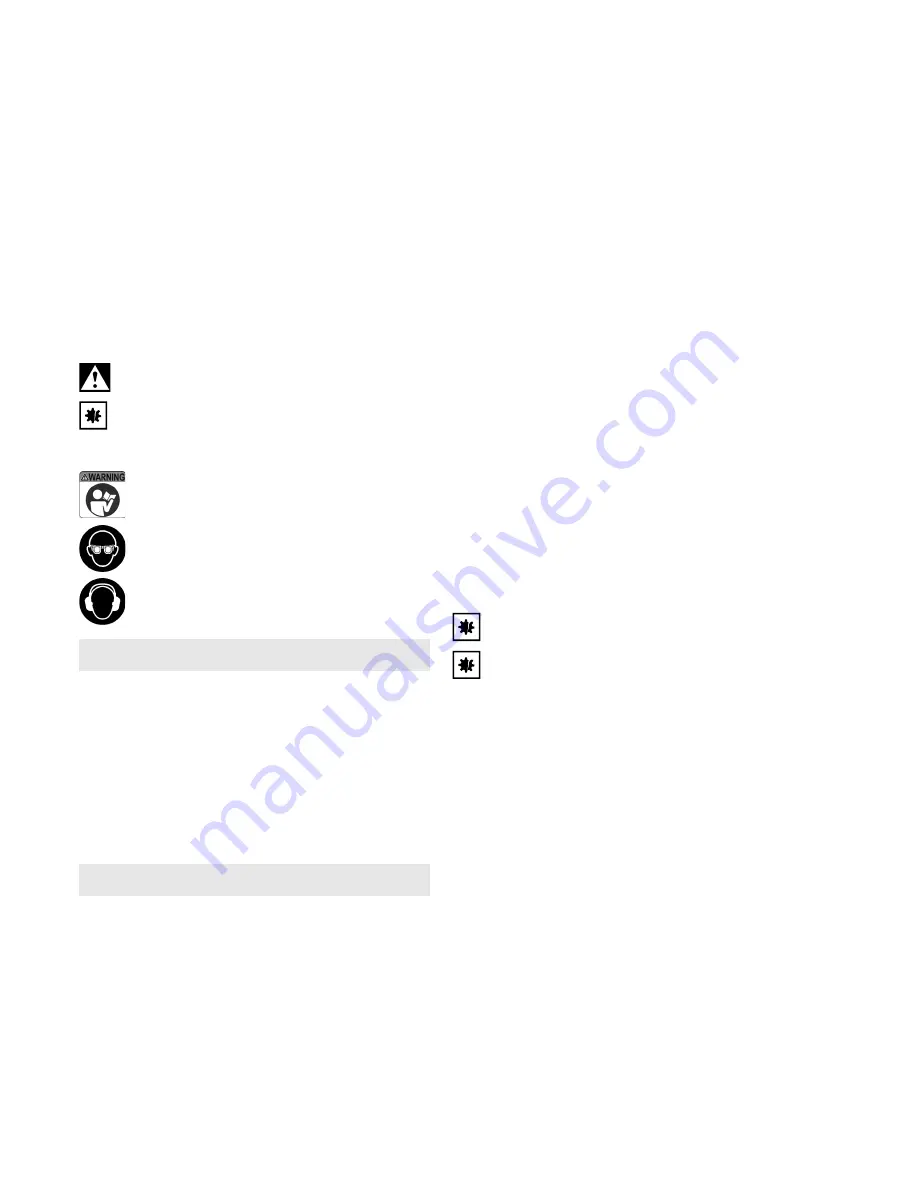
ENGLISH
en
11
suitable protective gloves, work clothing, safety
goggles and breathing protection with a filter
element suitable for the respective application!
- There is a risk of the injection of coating material
or cleaning fluid (e.g. when changing nozzles or
during cleaning)! Serious consequence can result
if the protective equipment is inadequate (e.g.
necroses, loss of limbs). There is also a risk in the
case of inhalation, contact or absorption of coating
materials or cleaning fluids. For this reason,
always provides adequate technical or natural
ventilation!
- Do not use the equipment in potentially explosive
atmospheres. Do not process materials that can
create potentially explosive atmospheres. Ensure
that only suitable compressed air is used!
Information in these operating instructions is cate-
gorised as shown below:
Danger!
Risk of personal injury or environ-
mental damage.
Caution.
Risk of material damage
4.9
Symbols on the air tool
Read the operating instructions before
starting to use the machine.
Wear safety goggles.
Wear ear protectors.
See Page 2.
1 Flowing cups/suction cups
2 Nozzle head
3 Regulating screw for round or wide-spray jets *
4 Air volume regulation *
5 Regulating screw for paint volume
6 Trigger lever
7 Plug-in nipple 1/4" *
* depending on features
6.1 Before using the tool for the first time
Insert plug-in nipple (7).
6.2 Setting paint jet:
Round jet / wide-spray jet
(depending on
features)
:
Use the regulating screw (3) to set the spraying gun
to a round or wide jet. See Fig. A, Page 2.
Round jet for small surfaces, corners and edges.
Wide jet for large surfaces. The nozzle head (2) can
be turned steplessly into vertical or horizontal posi-
tion.
Paint volume (application speed):
Set the paint volume at the regulating screw (5).
Open the regulating screw (5) by approx. 2 to 2
1
/
2
rotations and carry out a spray test.
Additional opening of the regulating screw (5)
increases the paint flow and thus the application
speed.
Closing the regulating screw (5) reduces the paint
flow and thus the application speed.
Because the material types vary, the paint volume
adjustment should always be carried out during
operation of the paint spraying gun.
HVLP (High Volume, Low Pressure):
(depending on features)
Min. supply pressure 0.7 bar at nozzle set, transfer
rate approx. 70%. Low overspray, maximum
transfer efficiency combined with low air consump-
tion; paint savings are up to 30%.
HVLP (High Volume, Low Pressure):
(depending on features)
Min. supply pressure 0.7 bar at nozzle set, transfer
rate approx. 73%. Low overspray, maximum
transfer efficiency combined with very low air
consumption.
6.3 Using the air tool
To benefit from the air tool's full performance,
always use compressed air hoses with an inner
diameter of at least 10 mm. Tool performance can
be significantly impaired if the inner diameter is too
small.
Caution.
The compressed air line must not
contain any water condensation.
Caution.
The compressed air used must be
cleaned and be free of condensate and oil.
1. Ensure that the air volume regulation (4) (de-
pending on features) is fully open prior to oper-
ation. It can be used for fine adjustment of the
air volume during operation.
2. Adjust the supply pressure (this is measured at
the air outlet while the air tool is switched on).
For details of the maximum permissible supply
pressure, see the section on "Technical Specifi-
cations".
If the supply pressure is too high, this can result
in excessively fine distribution of the material
accompanied by rapid fluid evaporation. The
surfaces become rough with poor adherence.
If the supply pressure is too low, the material is
insufficiently atomised. The surface will be
wavy with paint drips.
3. Connect the air tool with quick-action coupling
to the compressed air supply.
4. Observe the manufacturer's instructions on
paint conditioning. Fill paint into the cup (1).
Seal with cover.
5. Actuate the trigger lever (6) to put the paint
spraying gun into operation.
6. Set the paint jet (see Section 6.2).
5. Overview
6. Operation












































